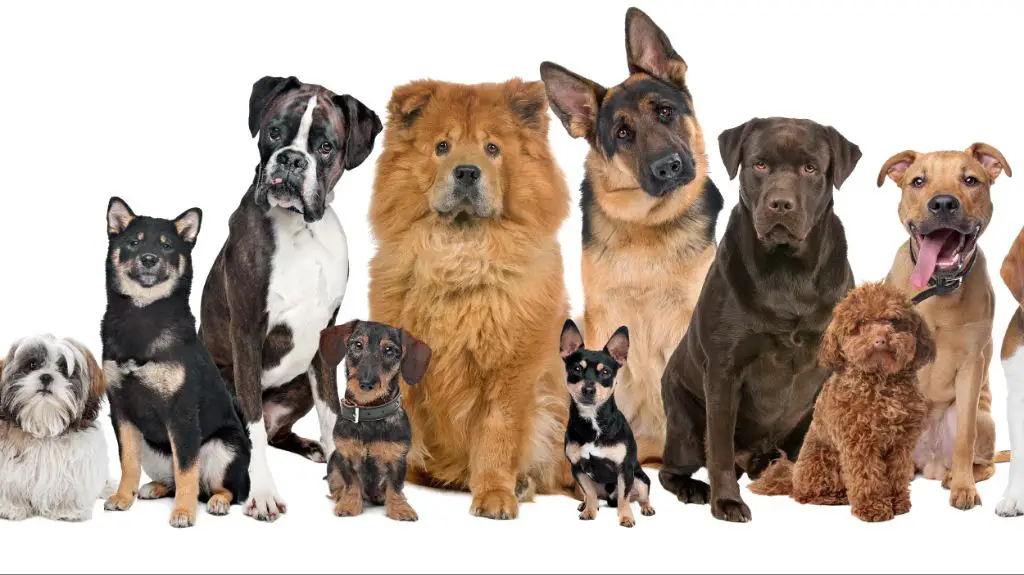Introduction
Dog brain size refers to the volume or weight of a dog’s brain. Some key points about dog brain size:
- Brain size is often used as a rough estimate of a dog breed’s intelligence and trainability.
- Larger dogs tend to have bigger brains than smaller dogs.
- However, brain size alone does not definitively determine intelligence.
- Brain size relative to body size is also an important factor.
- This article will provide an overview of dog brain size across different breeds.
- It will look at research on the correlation between brain size and trainability, behavior, health, and intelligence.
While brain size is one measure of canine cognition and ability, many factors influence a dog’s overall intelligence and behavior.
History of Dog Breeds

The origins of modern dog breeds can be traced back thousands of years. Dogs are descended from wolves and were the first animals that humans domesticated. While wolves evolved naturally over time, dog breeds were selectively bred by humans starting around 15,000 years ago.
The earliest dogs were bred primarily for practical purposes like hunting, herding, guarding and companionship. Over time, humans selectively bred dogs for specific traits and purposes, leading to distinct breeds with unique physical and behavioral characteristics.
One of the first steps in development of modern breeds was the division between hounds used for hunting and shepherd dogs used for herding sheep and protecting livestock. Further specialization led to breeds optimized for tracking, chasing, pointing at prey, retrieving and more. On the companionship side, toy breeds were developed to be household pets and lapdogs.
Victorian England saw a rise in breed development and breeding as a hobby. Breed standards were written to preserve unique breed characteristics. Many modern breeds originate from this time period, including some of the most popular ones like the Bulldog, Pug, Collie and Cocker Spaniel.
Today, the origins of over 400 recognized dog breeds can be traced to selective breeding by humans to produce dogs with specific physical and behavioral traits for different functions. From wolf ancestor to specialized breed, dogs are perhaps the animal that evolution and domestication have shaped the most in tandem with humans over history.
Measuring Brain Size
There are a few different methods used to measure dog brain size and volume:
MRI Scans: Magnetic resonance imaging (MRI) provides a non-invasive way to get detailed 3D images of dog brains. MRIs allow researchers to take accurate volumetric measurements of different brain structures.
Weight: A simple way to estimate brain size is to weigh the brain after removal from the skull. Generally, heavier brains are larger. However, this method doesn’t account for density.
Volume Displacement: Submerging a brain in a graduated cylinder filled with beads, seeds, or liquid is a technique used to determine volume. As the brain displaces liquid or particles, the volume can be read from the cylinder markings.
While weight and volume measurements provide rough estimates, MRI scans give the most precise measurements of overall brain size and allow detailed analysis of specific neuroanatomical structures.
Largest Breeds by Brain Size
Some dog breeds are known for their large brain size compared to other breeds. Three of the largest include Great Danes, Mastiffs, and Saint Bernards.
The Great Dane has one of the biggest brain sizes of any dog breed, with an average brain weight of 140-175g. Their large size is matched by their big brains. Great Danes are very gentle, patient and loving dogs. They are also quite intelligent and do well in obedience training when started young.
Mastiffs also have very large brains, averaging 160-190g. This big working breed is often thought of as one of the most intelligent breeds. They have a very loyal and protective nature. Mastiffs are great guard dogs and are often used by police and military. Their big brain gives them excellent ability to assess situations.
Another giant breed with a sizable brain is the Saint Bernard, with an average brain weight of 140-180g. Saint Bernards were originally bred as rescue dogs in the snowy Swiss Alps, needing intelligence to locate lost travelers. They are very trainable and often used as therapy and service dogs. Their big brain gives them gentle manner and ability to follow commands well.
These three large dog breeds stand out for having the biggest brains by weight. Their large size is matched by exceptional brain capacity compared to other breeds. This gives them trainability, intelligence and gentle dispositions ideal for many working roles and families.
Smallest Breeds by Brain Size
When it comes to small dog breeds, there are a few that consistently rank among the smallest in terms of brain size.
Chihuahuas, for example, are the smallest dog breed in the world, weighing just 4-6 pounds on average. They have a tiny, smooth brain that weighs only 5.28 grams on average. Their small stature and tiny brain are likely due to selective breeding to produce the world’s smallest dog.
Toy poodles are another minuscule breed, weighing 5-10 pounds. Their diminutive brains average around 28.12 grams. Like Chihuahuas, toy poodles were selectively bred to be a miniature version of the standard poodle.
Pomeranians are a spunky small breed weighing just 3-7 pounds. Their brains measure approximately 28.09 grams. Through selective breeding again, they were miniaturized from larger spitz-type dogs.
While their brains may be petite, these pint-sized pups have oversized personalities. Their small size makes them adorable companions. However, potential owners should be aware that their little brains may make training more challenging.
Brain Size and Trainability
There appears to be some correlation between a dog’s brain size and its trainability, though the connection is not entirely straightforward. In general, dogs with larger brains compared to their body size tend to be easier to train. This is likely because they can more readily understand human commands, solve problems independently, and retain learned behaviors.

For example, border collies, poodles, German shepherds and golden retrievers have large brains for their body size and are renowned as some of the most trainable dog breeds. On the other hand, breeds with proportionally smaller brains like basset hounds and bulldogs tend to be more difficult to train.
In particular, working dog breeds that have been selectively bred for tasks like herding, hunting and protection work tend to have larger brains. Their jobs require them to understand subtle commands, make independent decisions and demonstrate complex learned behaviors. A larger brain supports these capabilities.
However, it’s important to note that brain size is not the only factor in trainability. Other aspects like a dog’s energy level, motivation and temperament also play key roles. But in general, larger brained dogs do have an advantage when it comes to learning quickly and responding reliably to training.
Brain Size and Intelligence
There is an ongoing debate about the relationship between brain size and intelligence in dogs. Some studies have found correlations between brain size and certain cognitive abilities, while others have found little connection. Much of the research focuses on working, hunting and herding breeds that have been bred for independent thinking and problem-solving skills.
In general, larger dog breeds tend to have larger brains. However, brain size alone does not definitively determine how smart or capable a dog is. Several factors influence canine intelligence, including breeding history, training/socialization, motivation, health, and individual personality. Furthermore, intelligence is multi-faceted – skills like obedience, memory and problem-solving involve different cognitive processes.
While interesting, brain size itself may not be the best or only indicator of a breed’s overall intelligence. Smaller dog breeds can be just as adept at learning commands, interpreting cues and thriving in human environments. Playful interaction, bonding through positive reinforcement training, and providing mental stimulation are great ways to nurture a dog’s innate abilities, regardless of breed size and brain volume.
Brain Size and Behavior
A dog’s brain size has been linked to certain behavioral traits, although the correlation is not always clear-cut. Some key behaviors that relate to brain size include:
Aggression
Studies have found conflicting evidence on whether brain size correlates to aggression in dogs. Some studies show that dogs with smaller brains tend to be more aggressive towards humans and other dogs. This may be because they have lower inhibitory control over their impulses. However, other studies have found no correlation, indicating that aggression is a complex behavior influenced by many factors beyond just brain size.
Prey Drive
In general, dogs with larger brains tend to have a higher prey drive or urge to chase small moving objects. For example, sight hounds that were bred to spot and chase prey have larger brains and a higher prey drive compared to other breeds. The parts of the brain linked to visual acuity and coordination may play a role in prey drive.
Fearfulness
Some research indicates that dogs with smaller brains tend to be more fearful, nervous and reactive to perceived threats. Their decreased brain size may limit their ability to evaluate stimuli and respond appropriately. However, as with aggression, fearfulness is a complicated trait affected by genetics, socialization and life experiences.
While brain size can influence some behaviors in dogs, it does not solely determine a dog’s personality or temperament. A dog’s life experiences and training play pivotal roles in shaping behavior. Responsible ownership and proper socialization techniques should be employed to manage any undesirable behaviors.
Brain Size and Health
Smaller dog breeds tend to live longer than larger breeds, and brain size seems to be correlated with lifespan. Smaller dog brains are associated with a longer lifespan, while larger dog brains may lead to a shorter lifespan.

One of the main reasons for this is that larger dog breeds are more prone to certain neurological disorders that can shorten their lifespans. For example, larger dogs have higher rates of dementia, a condition associated with the degeneration and death of brain cells. Some research suggests that larger brain size may increase the risk of dementia development in dogs.
Large dog breeds also appear to be more susceptible to age-related cognitive dysfunction syndrome, which is similar to Alzheimer’s disease in humans. This neurological disorder causes confusion, memory problems, personality changes and disrupted sleep cycles. Again, having a bigger brain size seems to increase susceptibility.
In addition, larger breeds are prone to more calcium buildup in their brains over time. This cerebral calcification can lead to cognitive decline. Smaller dogs tend to have less calcification and are less impacted cognitively as they age.
Overall, while larger dog brains can confer some advantages like trainability, they also come with increased risks of neurological deterioration that can shorten lifespans. Smaller dog brains are associated with greater longevity and a decreased chance of disorders like dementia. So brain size does play an important role in a dog’s health and longevity.
Conclusions
In summary, this article has examined the relationship between dog brain size, breed, trainability, and health. We’ve seen that larger dog breeds, such as Mastiffs, Great Danes, and Saint Bernards tend to have the biggest brains. Smaller breeds like Chihuahuas, Yorkshire Terriers, and Pomeranians have the smallest brains. While brain size does seem to correlate somewhat with trainability and intelligence, this is not absolute – some smaller brained dogs are very intelligent, while some larger breeds may be more challenging to train.

When it comes to implications for breed standards, it’s important not to overemphasize brain size. Extremely large skull sizes in giant breeds are linked to health problems. Very small toy breeds may also face issues if the skull is drastically shrunken compared to what is typical for canines. Moderation and balance between brain size and overall health is ideal. No single factor like brain size should be the sole focus when developing breed standards.
In conclusion, while brain size can influence breed behavior and trainability to some degree, it does not determine a dog’s potential on its own. Many complex factors influence canine intelligence and temperament. Breed standards should account for brain size in balance with the overall health and wellbeing of the animal.